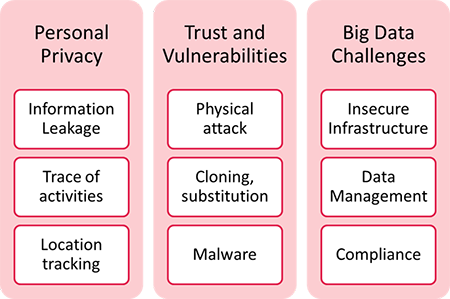The Internet of Things (IoT) provides opportunities for organizations to get closer to their customers and to provide products and services that are more closely aligned to their needs. It provides the potential to enhance the quality of life for individuals, through better access to information and more control over their environment. It makes possible more efficient use of infrastructure by more precise control based on detailed and up to data information. It will change the way goods are manufactured by integrating manufacturing machinery, customers and partners allowing greater product customization as well as optimizing costs, processes and logistics.
However the IoT comes with risks the US Federal Trade Commission recently published a report of a workshop they held on this subject. This report, which is limited in its scope to IoT devices sold or used by consumers, identifies three major risks. These risks are enabling unauthorised access and misuse of personal information, facilitating attacks on other systems and creating risks to personal safety. In KuppingerCole’s view the wider risks are summarized in the following figure:

Organizations adopting this technology need to be aware of and manage these risks. As with most new technologies there is often a belief that there is a need to create a new organizational structure. In fact it is more important to ensure that the existing organization understands and addresses the potential risks as well as the potential rewards.
Organizations should take a well governed approach to the IoT by clearly defining the business objectives for its use and by setting constraints. The IoT technology used should be built to be trustworthy and should be used in a way that is compliant with privacy laws and regulations. Finally the organization should be able to audit and assure the organization’s use of the IoT.
The benefits from the IoT come from the vast amount of data that can be collected, analysed and exploited. Hence the challenges of Big Data governance security and management are inextricably linked with the IoT. The data needs to be trustworthy and it should be possible to confirm both its source and integrity. The infrastructure used for the acquisition, storage and analysis of this data needs to be secured; yet the IoT is being built using many existing protocols and technology that are weak and vulnerable.
The devices which form part of the IoT must be designed manufactured, installed and configured to be trustworthy. The security built into these devices for the risks identified today needs to be extensible to be proof against future threats since many of these devices will have lives measured in decades. There are existing low power secure technologies and standards that have been developed for mobile communications and banking, and these should be appropriately adopted, adapted and improved to secure the devices.
Trust in the devices is based on trust in their identities and so these identities need to be properly managed. There are a number of challenges relating to this area but there is no general solution.
Organizations exploiting data from the IoT should do this in a way that complies with laws and regulations. For personal information particular care should be given to aspects such as ensuring informed consent, data minimisation and information stewardship. There is a specific challenge to ensure that users understand and accept that the ownership of the device does not imply complete “ownership” of data. It is important that the lifecycle of data from the IoT properly managed from creation or acquisition to disposal. An organization should have a clear policy which identifies which data needs to be kept, why it needs to be kept and for how long. There should also be a clear policy for the deletion of data that is not retained for compliance or regulatory reasons.
This article has originally appeared in the KuppingerCole Analysts' View newsletter.
















































